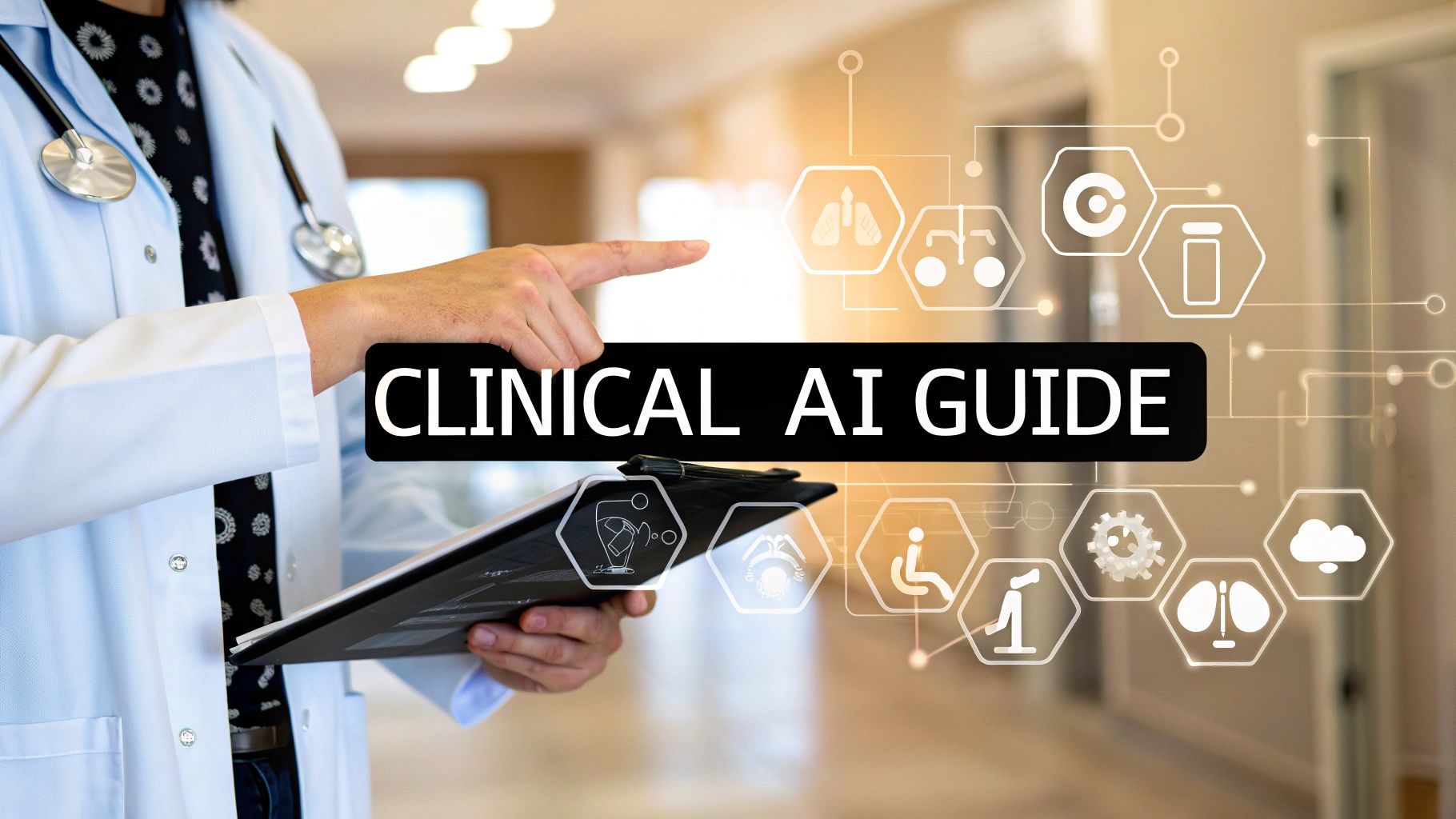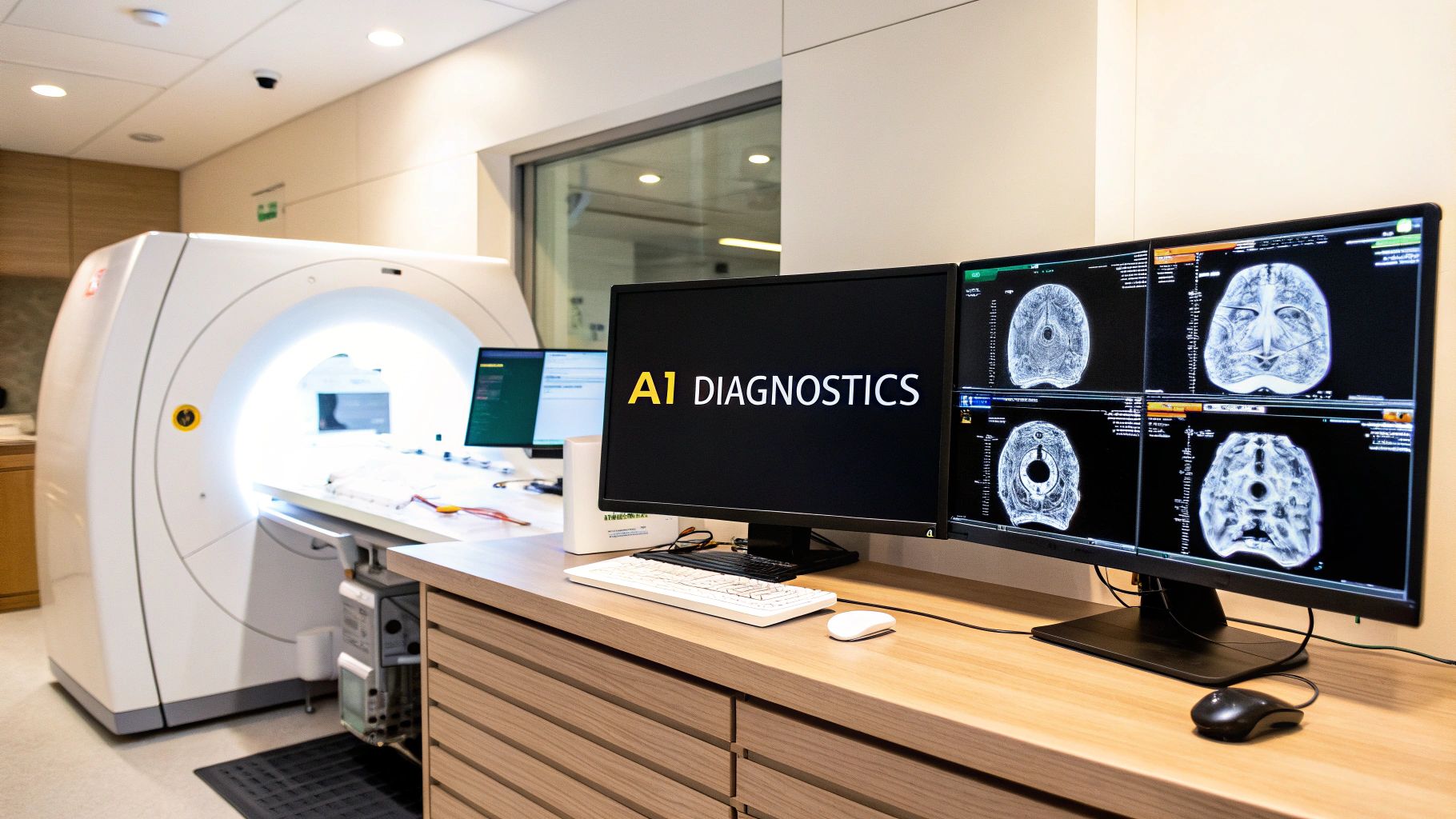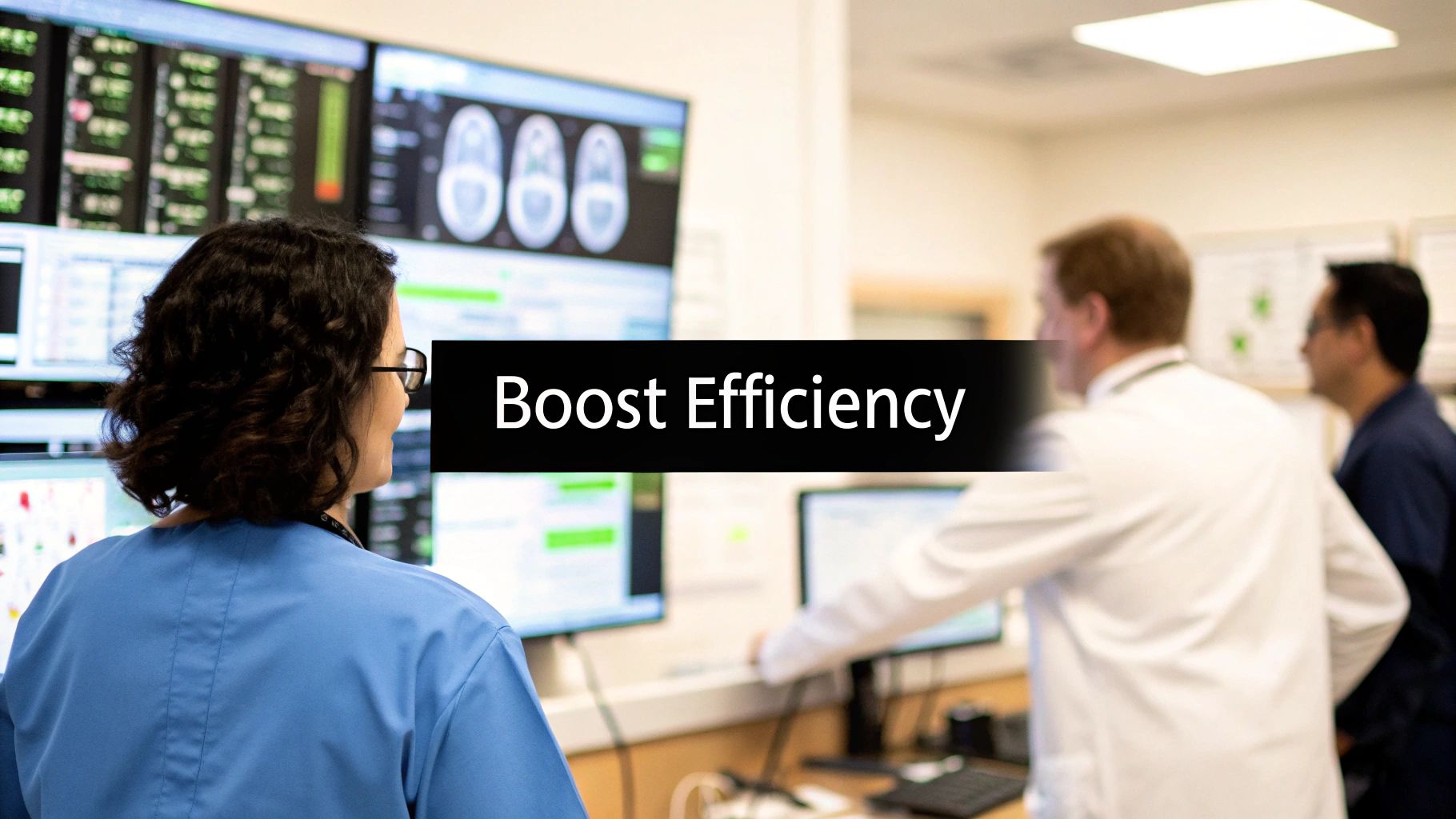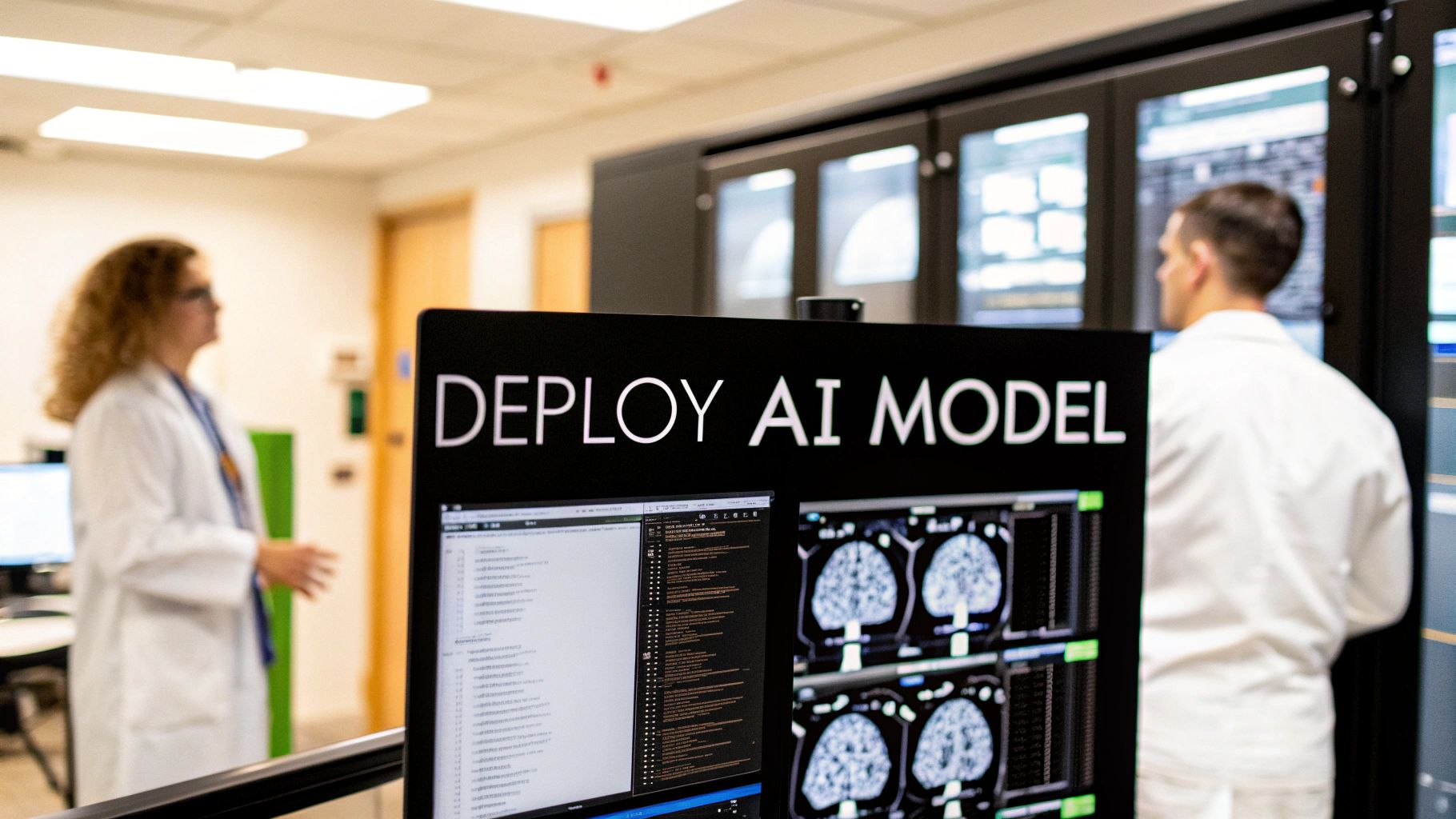Demystifying Medical Device Integration Software
Medical device integration software is essential in modern healthcare. It connects various medical devices and hospital information systems (HIS), enabling seamless communication and data flow. This creates a truly integrated ecosystem, improving patient care.
Key Components of Medical Device Integration Software
Understanding the core components of these systems is vital. These platforms handle complex data and facilitate real-time analysis. To illustrate these key components, the following table offers a breakdown of their function, complexity and overall value.
To help understand the building blocks of these crucial systems, let’s take a look at the table below outlining the key components.
| Component | Primary Function | Implementation Complexity | Integration Value |
|---|---|---|---|
| Device Interface Modules | Connects to individual devices, translating data into standardized formats. | Varies based on device complexity. | Essential for data aggregation. |
| Middleware | Acts as a central communication hub, routing data between devices and HIS. | Moderate to High. | Enables interoperability between systems. |
| Data Repository | Stores and manages the incoming device data. | High. | Crucial for data analysis and reporting. |
| Clinical Decision Support (CDS) Tools | Analyzes integrated data to provide real-time insights and alerts. | Moderate to High. | Allows for proactive, informed decisions. |
As you can see, each component plays a critical role in the overall success of the integration. From connecting to individual devices to providing valuable clinical insights, these components work together to create a powerful system.
The Role of Standardization and Interoperability
Various medical devices, each with its own communication protocol, create a significant challenge. Standardization protocols like HL7 and DICOM are essential. These standards ensure information from different devices can be understood and used across the healthcare system. This interoperability is fundamental to successful medical device integration.
Consider a patient undergoing surgery. Anesthesia machines, ventilators, and patient monitors generate significant data. Medical device integration software, using standardized protocols, collects and transmits this data to the electronic health record (EHR) in real time. This gives clinicians a complete view of the patient’s status, leading to better decisions and potentially life-saving actions.
This integrated data is also useful for long-term analysis and reporting, improving quality and aiding research. The global medical device connectivity market, which includes medical device integration, is growing rapidly. Valued at approximately $2.6 billion in 2023, it's projected to reach about $7.4 billion by 2028. This growth highlights the importance of connected medical devices in improving data management and patient care. For more detailed statistics, see this report: https://www.marketsandmarkets.com/Market-Reports/medical-device-connectivity-market-83792455.html. This underscores the crucial role of medical device integration software in modern healthcare.
The Game-Changing Benefits You Can't Afford to Miss

Medical device integration software is more than just a simple upgrade; it's a powerful tool for substantial improvements throughout healthcare. This means hospitals and clinics can experience tangible benefits that positively affect both their finances and, most importantly, the quality of patient care. Let’s explore some of these key advantages.
Enhanced Workflow Efficiency
One of the most immediate advantages is the improvement of clinical workflows. By automating data collection and transfer, medical device integration software removes the need for manual data entry, a process often susceptible to human error. This reduction in manual tasks allows clinical staff to focus more on direct patient care, increasing both efficiency and job satisfaction.
For example, nurses can spend less time on paperwork and more time interacting with patients, leading to more personalized attention and better patient outcomes. This improved efficiency creates a better patient experience and, ultimately, a higher standard of care.
Improved Clinical Decision-Making
Having quicker access to complete patient data significantly improves clinical decision-making. Medical device integration software gathers information from multiple sources, presenting clinicians with a comprehensive overview of the patient's status.
This real-time data access allows for faster, more informed decisions, which can lead to more timely interventions. Integrated systems often include clinical decision support (CDS) tools. These tools analyze data and offer evidence-based recommendations, further improving the quality of care. This easily accessible information results in more accurate diagnoses and individualized treatment plans.
Enhanced Patient Safety
By reducing manual data entry and providing real-time access to data, medical device integration software substantially lowers the risk of medical errors. Accurate and readily available information minimizes the possibility of misdiagnosis and incorrect treatments, resulting in better patient safety outcomes.
The automation features of this software also contribute to a safer environment, especially in critical care situations where timely and precise information is essential. This increase in accuracy and speed directly leads to a safer experience for patients.
Quantifiable Financial Impact
Beyond the clinical benefits, medical device integration software provides substantial financial advantages. Optimized device usage, decreased maintenance expenses, and shorter hospital stays contribute to a healthier bottom line.
For instance, hospitals can monitor the use and performance of their medical devices more effectively, allowing for proactive maintenance and reduced downtime. By streamlining workflows and enhancing patient care, these systems can contribute to shorter hospital stays and lower readmission rates, ultimately decreasing overall healthcare costs. These cost savings can be reinvested to further enhance patient care and hospital facilities.
Measuring Your Return on Investment (ROI)
Tracking specific key performance indicators (KPIs) is essential to demonstrate the value of medical device integration software. These metrics help quantify the positive impact on patient care and financial outcomes. The following table illustrates typical ROI metrics and expected timeframes for achieving these benefits.
To understand the financial benefits of medical device integration, let's examine some common ROI metrics that healthcare organizations track after implementation. The table below summarizes key performance indicators and their typical improvement range after integrating such a system.
| Benefit Category | Key Metrics | Typical Improvement Range | Time to Realize Benefits |
|---|---|---|---|
| Workflow Efficiency | Time spent on documentation, Number of patient visits per day | 10-20% decrease in documentation time, 5-10% increase in patient visits | 3-6 months |
| Clinical Decision Speed | Time to diagnosis, Time to treatment | 15-25% reduction in diagnostic time, 10-15% reduction in treatment time | 6-12 months |
| Patient Safety | Medication errors, Adverse events | 10-20% reduction in errors, 5-10% decrease in adverse events | 12-18 months |
As shown in the table, improvements in workflow efficiency can be seen relatively quickly, within 3-6 months, while benefits related to patient safety may take longer to materialize (12-18 months).
By concentrating on these measurable enhancements, healthcare providers can clearly demonstrate the value of investing in medical device integration software. This data-driven strategy justifies the initial investment and highlights the long-term advantages for both the organization and, more importantly, the patients they serve.
Software As a Medical Device: The Integration Revolution
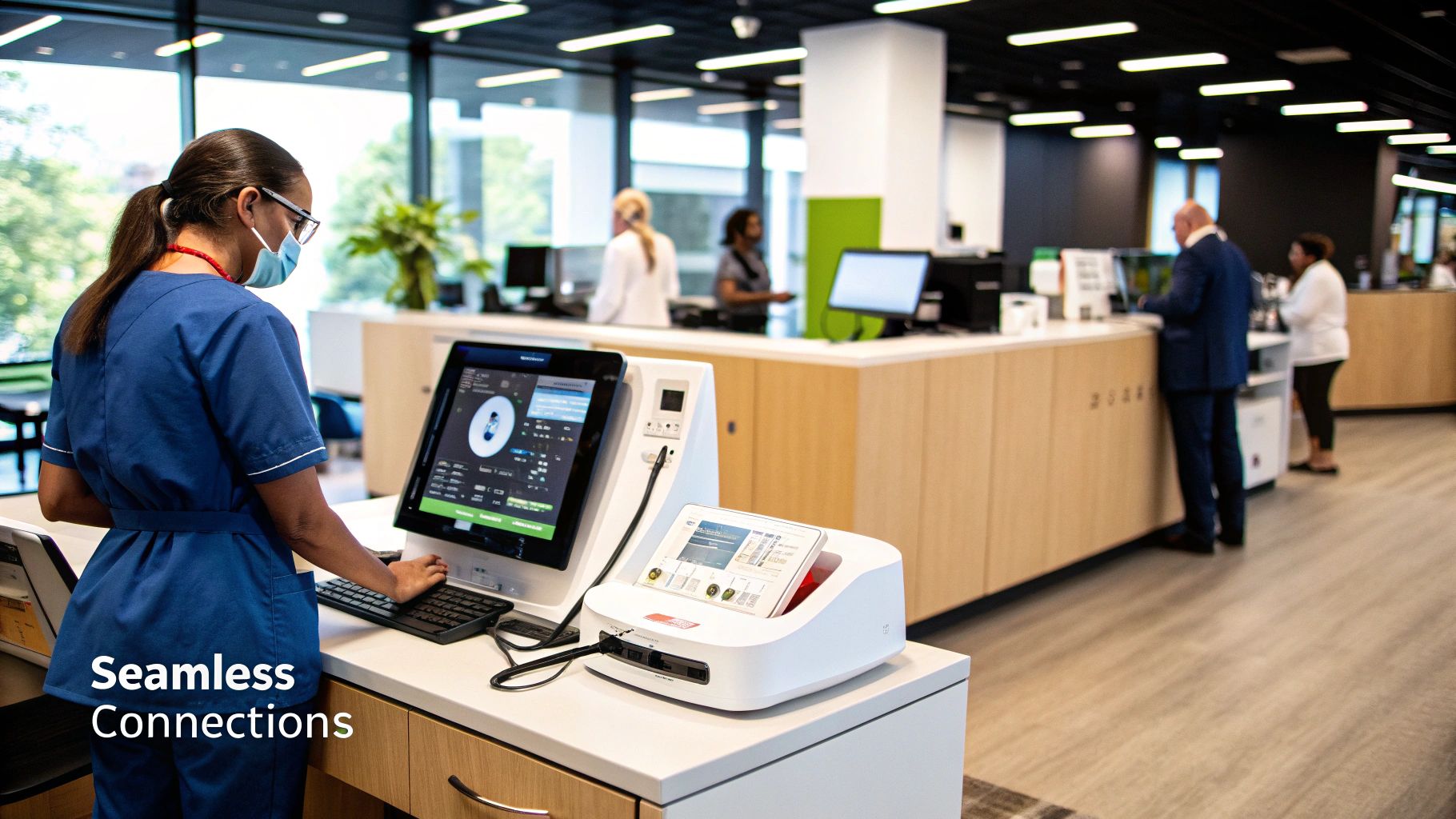
The lines between medical devices and software are increasingly intertwined. This intersection has given rise to a new category: Software as a Medical Device (SaMD). SaMD is rapidly changing how we approach medical device integration. It's no longer simply about connecting hardware; it’s about integrating intelligent software solutions into the very fabric of healthcare.
Understanding The SaMD Landscape
SaMD represents a fundamental shift in healthcare technology. Unlike traditional software, SaMD is designed to directly diagnose, treat, or prevent diseases. This critical distinction has significant regulatory implications, requiring a different approach to development, testing, and deployment.
For example, an app analyzing heart rhythm data to detect atrial fibrillation would be classified as SaMD. A simple pedometer app, however, would not.
Advancements in artificial intelligence (AI) and machine learning (ML) drive this evolving landscape. These technologies empower SaMD to offer personalized and predictive care interventions. This means patients receive more targeted treatments and proactive care based on their individual needs and risk factors, ultimately leading to better outcomes and a higher quality of care.
The increasing adoption of SaMD also carries substantial market implications. Driven by AI and ML, the global SaMD market is estimated to be valued around $1.8 billion by 2024. This market is projected to reach approximately $6.1 billion by 2034, growing at a CAGR of roughly 13%. Find more detailed statistics here. This impressive growth highlights the expanding role of software in reshaping medical care.
Integration Challenges and Solutions
Integrating SaMD into existing clinical workflows presents unique challenges. Healthcare organizations must navigate complex technical landscapes, including data security, interoperability, and legacy system compatibility. Furthermore, staff training and change management are critical for successful SaMD adoption.
However, forward-thinking institutions are developing innovative solutions. Many are adopting cloud-based platforms and API-driven architectures to improve flexibility and scalability. Others are implementing robust data governance strategies to protect patient privacy while maximizing the value of integrated data. These pioneers are creating truly intelligent patient care ecosystems where data flows seamlessly between SaMD, medical devices, and healthcare information systems. This integrated approach facilitates real-time insights, improved decision-making, and ultimately, better patient care.
The Future of Integrated Care With SaMD
SaMD is not merely a fleeting trend; it's a fundamental shift in the future of healthcare. As AI and ML continue to advance, SaMD will become even more sophisticated. It will offer more accurate diagnoses, personalized treatment plans, and proactive health management tools. This transformation promises a future where healthcare is more precise, efficient, and patient-centered. The continued development and integration of SaMD will play a vital role in shaping this future of connected, intelligent care.
Conquering Implementation Hurdles: From Roadblocks to Results
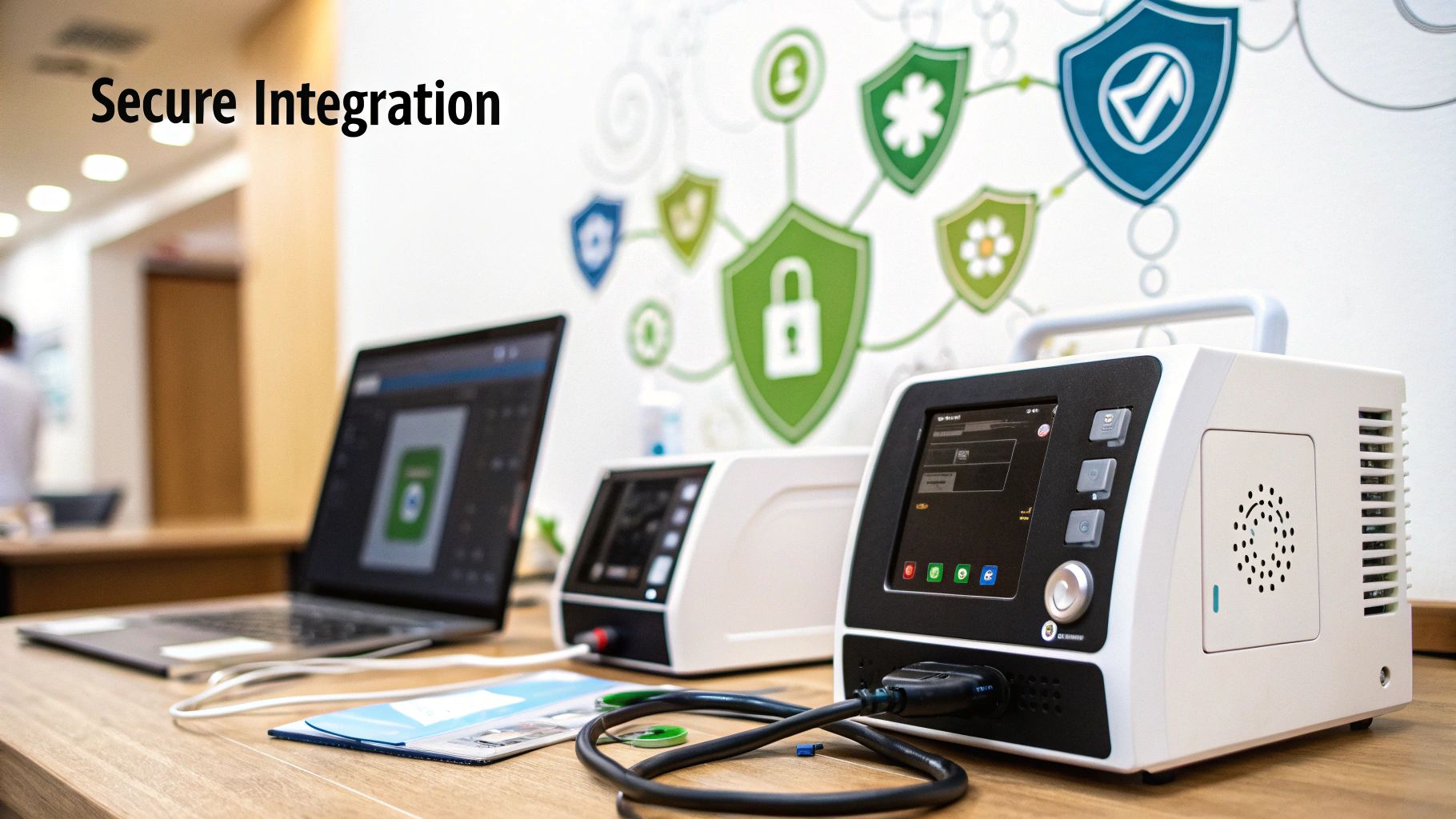
Integrating medical device integration software is a complex process. However, with a structured approach, healthcare organizations can significantly ease the transition and maximize its benefits. This section explores common challenges and practical strategies for successful implementation.
Common Implementation Challenges
Several potential roadblocks can emerge during the implementation of medical device integration software. Understanding these challenges is the first step toward effectively addressing them.
-
Legacy System Compatibility: Integrating new software with older systems can be a major hurdle. Often, these legacy systems lack the interfaces or data formats necessary for seamless communication.
-
Data Standardization: Medical devices often use various data formats and communication protocols. This lack of standardization requires careful planning and potential data transformation to ensure interoperability.
-
Network Infrastructure: Medical device integration software often requires a robust network infrastructure capable of handling increased data flow. Insufficient bandwidth or network instability can negatively impact performance.
-
Stakeholder Alignment: Successful implementation depends on the buy-in from all stakeholders. This includes clinicians, IT staff, and administrators. Misaligned goals or resistance to change can derail a project.
-
Workflow Disruption: Implementing new software inevitably disrupts established workflows. Minimizing this disruption and providing adequate training are critical for user adoption.
Strategies for Success
Proactively addressing potential challenges significantly increases the likelihood of a successful implementation. The following strategies provide a roadmap for navigating these complexities.
-
Thorough Assessment: Begin with a comprehensive assessment of your current systems, workflows, and stakeholder needs. This helps define clear goals and identify potential compatibility problems early on.
-
Phased Approach: A phased implementation minimizes disruptions. Start with a pilot program in a specific department, then gradually expand to other areas of the organization.
-
Strong Integration Partner: Choosing an experienced integration partner with a proven track record is essential. A strong partner provides technical expertise and valuable guidance throughout the implementation.
-
Change Management Plan: A detailed change management plan addresses potential resistance to new software and ensures user adoption. This should include comprehensive training and ongoing support.
-
Resource Allocation: Allocate sufficient resources—budget, staff, and time—to the project. Insufficient resources can lead to costly delays and compromise the implementation’s success.
Evaluating and Selecting Integration Partners
Choosing the right integration partner is paramount to a successful implementation. Consider the following criteria when evaluating potential partners:
-
Experience: Prioritize partners with proven experience in medical device integration, specifically within your area of healthcare.
-
Technical Expertise: Ensure the partner possesses deep technical expertise in the specific software and relevant technologies.
-
Support and Training: Evaluate the partner’s ability to provide comprehensive training and ongoing support to your staff.
-
References: Request client references and case studies to gauge the partner’s track record and assess client satisfaction.
Real-World Case Studies
Analyzing case studies of both successful and unsuccessful implementations can provide valuable insights. Studying these cases offers a deeper understanding of best practices, common pitfalls, and strategies for overcoming obstacles.
For example, one hospital successfully integrated medical device data with its EHR system, resulting in a 15% reduction in documentation time. This success was attributed to meticulous planning, strong stakeholder engagement, and a phased implementation approach. Conversely, another hospital encountered significant challenges due to inadequate network infrastructure, resulting in project delays and performance issues. This example highlights the crucial need to thoroughly assess existing infrastructure before starting any implementation.
By learning from these real-world experiences, healthcare organizations can avoid common mistakes and ensure a smoother, more efficient implementation process. This proactive approach is key to transforming implementation roadblocks into tangible, positive outcomes.
Building the Connected Healthcare Ecosystem
Medical device integration software isn't a standalone solution. It thrives within a larger, interconnected healthcare IT ecosystem. Forward-thinking healthcare organizations recognize this and are strategically positioning their integration efforts within this broader framework. This allows for a better flow of information and stronger communication between various healthcare systems.
Integrating with Core Systems
Medical device integration software enhances the capabilities of other critical systems, especially electronic health records (EHRs). By seamlessly transmitting data from various devices directly into the EHR, manual data entry is eliminated. This reduces errors and frees up clinicians' valuable time. This integration also benefits clinical decision support systems. Real-time data from connected devices provides a more complete picture of the patient's condition, allowing for more precise and timely interventions.
Medical device integration software also plays a vital role in telehealth platforms. Remote patient monitoring depends on collecting and transmitting data from in-home devices to healthcare providers. This continuous data stream enables proactive interventions and reduces the need for frequent hospital visits. The integrated data also provides valuable input for analytics tools. This facilitates population health management, trend analysis, and continuous improvement initiatives.
The Importance of Interoperability Standards
Achieving this level of integration relies on adhering to interoperability standards like HL7, FHIR, and DICOM. These standards ensure that different systems "speak the same language," defining how healthcare data is structured, coded, and exchanged. This allows seamless communication between various devices and software platforms.
For instance, DICOM, the standard for medical imaging, allows radiology departments to seamlessly integrate imaging devices with Picture Archiving and Communication Systems (PACS) and EHRs. This gives radiologists access to images and reports from any location, increasing efficiency and improving patient care. HL7 and FHIR facilitate the exchange of clinical data between different healthcare systems, enabling a more holistic view of the patient.
Emerging Integration Approaches
The healthcare IT integration market, which includes medical device integration, is rapidly expanding, driven by the increasing adoption of EHRs and telehealth. Valued at approximately $3.9 billion in 2021, this market is projected to reach $7.1 billion by 2026, showing a CAGR of 12.4%. Medical device integration is key to optimizing healthcare processes, improving data analysis, and supporting remote patient monitoring. More detailed statistics can be found here: https://www.marketsandmarkets.com/Market-Reports/healthcare-it-integration-market-228536178.html
New technologies are also impacting how we approach medical device integration. API-based architectures are gaining popularity, offering greater flexibility and scalability. APIs allow different software systems to communicate with each other in a standardized way, simplifying the integration of new devices and applications.
Cloud platforms are also playing a crucial role. Cloud-based medical device integration software offers numerous advantages, including reduced infrastructure costs, improved accessibility, and enhanced scalability. Cloud solutions enable collaboration across multiple healthcare organizations, facilitating better data sharing and care coordination.
These evolving integration strategies support innovative care models such as remote monitoring, hospital-at-home programs, and value-based care initiatives. These models rely on integrated device data to provide personalized, proactive, and cost-effective care. As healthcare continues to advance, medical device integration software will be essential in shaping the future of connected health.
Safeguarding Your Integration: Security Strategies That Work

Protecting your medical device integration software is paramount in healthcare today. This section explores practical security strategies for safeguarding these integrated systems without impacting their functionality.
Understanding the Cybersecurity Challenges
Connecting medical devices introduces unique cybersecurity vulnerabilities. Many medical devices, unlike traditional IT systems, lack robust built-in security. This makes them vulnerable to threats like malware, ransomware, and data breaches. The increasing interconnectedness of these devices expands the potential attack surface, making security even more crucial. For example, a compromised infusion pump could be manipulated to deliver an incorrect dosage, putting patient safety at risk.
Practical Mitigation Strategies
Protecting medical device integration software requires a multi-layered approach. Network segmentation is crucial. This isolates different parts of the network to contain potential breaches. Imagine separate compartments in a ship; if one floods, the others stay sealed, preventing the entire ship from sinking. Another key strategy is access control. This restricts access to sensitive data and systems to authorized personnel only, minimizing unauthorized access and data breaches.
Navigating the Regulatory Landscape
Healthcare organizations must also navigate complex regulations. These include HIPAA, GDPR, FDA guidelines, and ISO 27001. HIPAA mandates safeguards for Protected Health Information (PHI). This requires robust security measures to ensure patient data confidentiality, integrity, and availability. GDPR imposes strict data protection requirements for European Union citizens. Complying with these regulations requires strong security protocols and data governance frameworks.
Best Practices for Medical Device Ecosystems
Several best practices address the security challenges of medical device ecosystems. These include regular risk assessments to identify vulnerabilities and prioritize mitigation. Regular vulnerability scanning is also essential. This identifies weaknesses in software and systems before exploitation. An effective incident response plan is also vital. This ensures a swift, coordinated response to security incidents, minimizing damage and downtime. Like a fire drill, a well-rehearsed incident response plan prepares the organization to handle breaches effectively.
Data Governance and Patient Information
Protecting patient information is a primary concern. Strong data governance policies are essential. These policies define who accesses what data, how data is used and stored, and how it's protected throughout its lifecycle. They should address data encryption, access control, and data retention. This protects patient information while enabling the benefits of connected care technologies. This balanced approach allows for data-driven insights while upholding patient privacy.
The Future of Medical Device Integration: What's Next?
The world of medical device integration is constantly changing. For healthcare leaders, understanding these emerging trends is vital for staying competitive and prepared for the future of connected care. This means anticipating how new technologies will shape medical device integration software and affect their organizations.
Edge Computing: Bringing Intelligence to the Device
Edge computing is set to reshape medical device integration. This technology processes data closer to the source—the medical device itself. This reduces latency, a critical factor for time-sensitive applications like remote patient monitoring and surgical robotics. Imagine a surgeon performing a robotic surgery. Edge computing enables the robot to react instantly to the surgeon's commands, minimizing delays and enhancing precision. This shift allows devices to handle complex computations independently, making them more intelligent and responsive.
5G Connectivity: Expanding the Reach of Remote Care
The growth of 5G networks offers significant opportunities for medical device integration. 5G's high speed and low latency expand the potential of remote monitoring. This means patients can receive care in various locations, from rural areas to their homes. For example, a patient with a chronic heart condition can have continuous monitoring through a wearable device that transmits data in real time to their physician via a 5G network. This allows for quick interventions. This improved connectivity broadens the reach of healthcare services and changes how care is delivered.
Blockchain: Securing the Chain of Trust
Blockchain technology offers a novel approach to securing the chain of trust for medical device data. By creating a permanent record of each data transaction, blockchain strengthens security and prevents tampering. This is especially important in situations where data integrity is essential. Consider a patient's medical record. Blockchain ensures the record's accuracy and prevents unauthorized changes, protecting sensitive data and building trust between patients and providers.
Digital Twins: Optimizing Integration Scenarios
Digital twins, virtual models of physical devices, are becoming important tools for improving integration scenarios. These twins allow developers to simulate and test integrations in a secure, controlled setting before actual deployment. This helps identify and resolve potential problems before they affect real-world systems. For example, before installing a new infusion pump system, a digital twin can simulate its integration with the hospital's network and EHR system. This allows for adjustments and refinements without disrupting patient care. This approach mitigates risks, streamlines implementation, and boosts integration effectiveness.
Ambient Intelligence and Voice Interfaces: Transforming Clinician Interactions
The future of medical device integration also includes a more intuitive interaction between clinicians and technology. Ambient intelligence and voice interfaces are creating more intelligent and user-friendly care settings. Imagine a doctor verbally requesting a patient's vital signs. The integrated system automatically retrieves and displays the information without any manual entry. This simplified approach reduces workload, minimizes distractions, and lets clinicians focus on their top priority—patient care. These technologies are changing how healthcare professionals interact with data, creating more efficient and patient-centered workflows.
Ready to experience the future of medical device integration? PYCAD, a leading AI medical imaging integration company, offers advanced solutions to optimize medical devices and improve healthcare outcomes. Visit PYCAD to learn more and explore how their expertise can help your organization.


